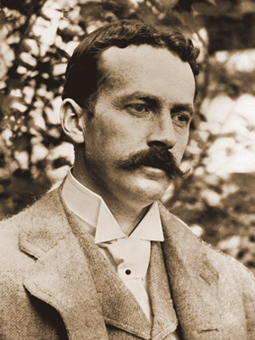[This post at first might not seem relevant to woodworking - have patience and keep reading.]
Last week's post was about my visit to the Stickley Museum in Morris Plains, NJ. During that trip back East, I also visited a couple other woodworking-related museums. This post is about the first of those: the home and museum of Henry Chapman Mercer.
 |
Henry Mercer
(Picture from Wikipedia) |
Henry Mercer chose his parents very well. He was a child of privilege, being born into wealth. He attended Harvard and later studied law at U. of Pennsylvania. He never practiced law, however. He traveled throughout Europe for much of the 1880's, and after his return he spent much of the 1890's as curator of American and Prehistoric Archaeology at the U. of Penn Museum. It's my guess that this only added to his interests in archaeology, paleontology and history, among other things.
Mercer is famous his ceramic tile manufacturing plant and for the concrete castle he built around 1908-1912 in Doylestown, PA. The tour guide said that Mercer once built a bonfire on an upper floor balcony of the castle just to show how the castle was fireproof. The fire drew the attention of many fire-fighters who responded to the scene, only to find no help was needed.
 |
| Fonthill Castle |
Fonthill Castle was an interesting structure, made mostly of poured, reinforced concrete. Some of the furniture even had concrete casework. Chests of drawers were built-in and had carcase of concrete and drawers of wood. Bookcases were made similarly.
 |
| Chest of drawers made from concrete with drawers of wood |
 |
This support column shows the grain of the wooden "mold"
that was used to form it. |
But the really unbelievable thing about it was the tile. Practically every floor, wall and ceiling was covered with tiles that he either made in the tile manufacturing plant or that he had collected from throughout the world.
 |
| A ceiling decorated with tiles |
 |
| Another ceiling just loaded with tile |
 |
| Tiles above a doorway |
Many of his tiles displayed aspects of early American rural life. And while the tile work was the main show, there were a few interesting pieces of furniture.
 |
| A nice long Windsor-style bench |
 |
| And interesting chair |
You could see through his tiles that Mercer had a soft spot for early American life. He felt that industrialization was destroying American society (much like the thinking behind the Arts and Crafts Movement). It was partly for this reason that he started collecting tools and other items that were rapidly being lost to antiquity. He collected so many things over the years (over 30000 objects) that he decided to build a museum. Hence the Mercer museum was born.
This museum, also in Doylestown, PA, was fantastic. It had sections devoted to individual aspects of early rural life. Things like all the tools, barrels and knick-knacks needed for butter churning and storage. You wouldn't believe how many things were needed for meat tenderization, preparation and storage. Hay raking, gunpowder making, fruit preservation, nail making, coopering, cider making, the list goes on and on. There were stagecoaches and boats hanging from the main atrium ceiling! Everything was made of wood, metal and sometimes a little leather.
 |
Horse-drawn carts hanging in the atrium
(check out the size of the monstrous wooden screw at left) |
 |
| Some cooper's tools |
 |
More cooperage tools - something's not right with the long stave-jointing plane.
Can anybody put a finger on it? Seems like the plane body is upside down and iron is in the wrong way! |
All of this stuff was great and I could have spent several days here and not seen enough. But I couldn't wait to get the the woodworking exhibit. Unfortunately the exhibit was behind glass, so some pics don't look so good.
 |
| Yours truly at the woodworking exhibit |
 |
| A big-ass frame saw, with several types of ax on the back wall |
 |
| A nice old chest loaded with moulding planes |
 |
| Wooden braces |
 |
| An interesting treadle lathe (there were 2-3 others in the exhibit) |
 |
| An old saw with user-made handle |
 |
| A (probably) not-as-old saw with broken, more ornate (mass-produced?) handle |
And in another area of the museum were some cool lathes.
 |
| There's a "great wheel" behind the concrete pillar attached to the right-most (cast metal) lathe |
 |
Interesting treadle lathe with wooden frame and metal head- and tail-stocks and treadle wheel.
Note the changeable pulley sizes for adjustable lathe speeds |
Just so much stuff. It was tool porn to be sure. I could've stayed there for many more hours, but unfortunately time was running short. Bummer.
Henry Chapman may not have been a woodworker, but he did the woodworking world a huge favor with his collections and museum.















































